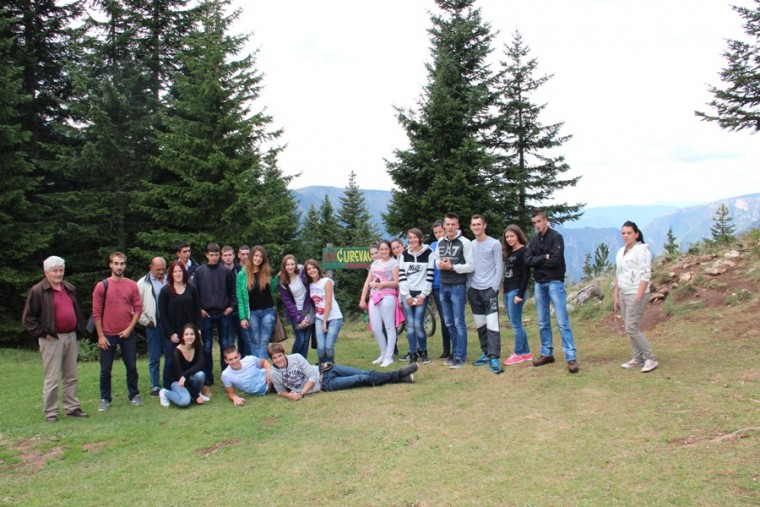Within the activities of the “Tour natural heritage sites and collecting materials” in Zabljak in the period from 10.09. till 13.09. 2015 held the second of 6 planned visits to sites of natural heritage. On this occasion, the participants visited destinations: Curevac, Tepca and Crna Poda and learn more about the endemic and relict species endemic to the area of Durmitor and Tara canyon.
Durmitor is a regional whole, zasijenčena with five canyons, the diversity of flora and fauna owes touch of two great geographical regions: the Mediterranean and evrosibirskog. It is estimated that in this area there are more than 1,500 plant species. Some of them have their origin in the distant geological past, and on the slopes of the massif ovogplaninskog can find species that are characteristic of the distant Arctic. In the canyons of Piva and Tara, are preserved some kind of tertiary flora from the Ice Age, and peatlands in the Durmitor lakes are enclaves, characteristic of the Siberian taiga.
Endemic 15% of the alpine flora (122 species), while the total endemic flora of the Durmitor’s massif, 77% are high-mountain endemic.
In the higher interesting areas, are the most abundant conifers: spruce, fir and pine, and deciduous trees: birch, beech, aspen and maple. In the lower part called to grow even ash, oak, elm, linden, maple, dogwood and more. Rare species whitebark pine, yew, calico, dwarf pine and juniper.
Very interesting and rare occurrence of so-called “forest inversion”, because in many places above the level sawmills, reports covering deciduous vegetation beech. The abundance and diversity of plants on the meadows and the cliffs of Durmitor is still undetermined, but many species are protected because of exceptional scientific importance. There grow many endemic species: mullein, NIKOLINA LJUBIČICA, MONTENEGRO ZVONČIĆ, MALIJEV jeremicak, RAUN BRAKEOV valerian, Tarski bluebells, lady’s slipper, Siparska HAJDUČICA, younger, sneaking BELL, DINARSKA gentian … On Durmitor growing over 40 species of wild edible mushrooms and is considered a special reserve in Europe.
This area is populated and diverse fauna, about 300 animal species are protected. By curiosities and wealth, the first place belongs to invertebrate, with a large number of rare and endemic species, especially among insects. In summer, the flowery meadows, as nowhere else, one can see a multitude of different species of butterflies and beetles (about 130 species of butterflies), and among them the Apollo, which is due to its beauty, the most frequent targets of collectors and was placed under protection. Mammal world consists of bear, chamois, roe deer, wolf, hare, wild boar, marten, fox, dormouse and others, while the otter, which lives in the Tara River among rarities in Europe. On Durmitor area there are 168 species of birds, including rarities are great TATRIJEB, eagle, partridge, hawk, KRSTOKLJUNKA, griffon vulture …
Curevac (1625 m). From here on the one hand see the panorama of Durmitor, the other Tara canyon in the meandering flow of the stone cliffs. The vertical of over a kilometer leading to the village, called Tepca, with countless Arc, formerly cultivated terrace stretches along the left bank of Tara. Winds that way “Tear of Europe” at about 550 meters above sea level. Like a cut furrow between mountain peaks flows clear mountain river, and its water from time to time make for wonderful landscapes in tame and fertile valleys in which acres, orchards, forests and meadows with grazing herds of sheep and goats, very often together with game , which is full of valleys and river canyon. The river flows even further through the abyss over which, on its stony slopes the lonely pines that arise, it would seem, from the stone cliff, which plunges into the depths of the abyss of this famous canyon.
Due to the quality of its water and the unique eco-system, Tara in 1977 included in the program “Man and Biosphere” and an ecological biosphere reservation, which is protected by internationally adopted convention.
The flora of the Tara has managed to preserve many species of plant life originating from the distant past. And most interestingly, many of these species have managed to preserve their primordial characteristics typical of the past. Thus, in the valleys of the Tara we meet preserved certain types of tertiary flora from the Ice Age. Besides these species, plant life in the canyon is characterized by forests of different species: oak, ash, beech, black ash and birch. A large part of the canyon are overgrown with needle trees, and among them a special place for the black pine.
The most interesting of the black pine are those which hang on naked stony slopes, and thus hang over precipitous abysses. But the most famous site where the black pine of the primeval forest, located in the canyon at a place called Black floor. Black floor have been designated as a strict nature reserve. Black floor, 1.5 km long and 500m wide, jungle black pine reserve in which the tallest trees in Europe (50 m), aged 400 years. On this site alive and beautiful orchids Europe, lady’s slipper, which is a protected species and it is estimated that the area of the Black Poda has only about 50 specimens of this species.
In this tour was attended by 30 students (15 from Foca and 15 from Zabljak), together with their professors.
Created a lot of photos and video clips, which are later processed together in the school premises.
A large number of students, from both sides of the border, expressed his wish to continue the meetings and participate in future projects.
As part of the tour participants visited the Natural History Museum of the Durmitor National Park.



 BiH
BiH MNE
MNE